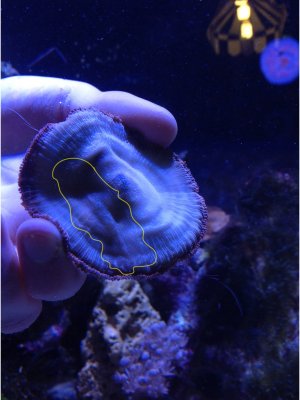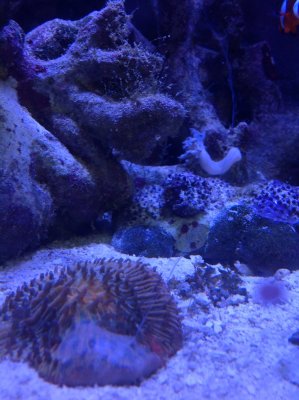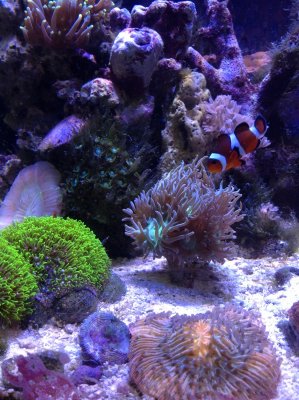I’m seeing some strange organisms in my tank at night. At first I thought vermetid snails but I don’t see any tube-like shell. These sweepers or whatever they are, are VERY long, some probably 12-13 inches. They are soft and fuzzy at the base and I can pick them off with a tweezers. You can really see one of them in the video.
Navigation
Install the app
How to install the app on iOS
Follow along with the video below to see how to install our site as a web app on your home screen.
Note: This feature may not be available in some browsers.
More options
You are using an out of date browser. It may not display this or other websites correctly.
You should upgrade or use an alternative browser.
You should upgrade or use an alternative browser.
Very long sweepers at night. Need help to ID
- Thread starter Kopka
- Start date
- Tagged users None
I hoe you find out what that is!
Thanks. Me too. They are only seen at night and they do bother my zoas. Not sure if they are out during the day and i just cant see them.I hoe you find out what that is!
how long do they take to extend? retract? if you turn off the lights during the day and shine your light at them do you see them? by the way hoe means hope. i just saw that mistype, lol
Crabs McJones
I'm so shi-nay
View Badges
Excellence Award
Reef Tank 365
Article Contributor
Moderator Emeritus
Hospitality Award
Reef Tank 365 Boss
Wisco Reefers
My Tank Thread
I think they're benthic ctenophores. Harmless filter feeders.
Last edited:
You might be correct, thank you. I’ve never seen these in any of my tanks over the years. They seem to be multiplying I have a lot of them. This tank is fairly new so I only have a few frags of Zoas and they seem to bother them a lot at night. Worried they will really bother some sps frags.I think they're ctenophores. Harmless filter feeders.
Bringing this back up in case anyone else has experience with these. Pretty positive that they are Ctenophores. They are multiplying like crazy. Can only see them at night but they are everywhere. Just want to make sure they dont sting or anything like that.
If they have an available food source, then you'll see their population grow. As your tank matures, you'll see more and more critters, especially at night. Nighttime viewing is just as cool as daylight. That's what makes reefing so amazing, the proliferation of life and biodiversity.
This is true but more specifically I'm asking if anyone has any experience with these and if they can bother/smother corals. Seems like they can reproduce rapidly. I've never had them before and from my research it seems they are pretty rare in in the hobby. Thanks.If they have an available food source, then you'll see their population grow. As your tank matures, you'll see more and more critters, especially at night. Nighttime viewing is just as cool as daylight. That's what makes reefing so amazing, the proliferation of life and biodiversity.
I wouldn't call them rare, it's just that there are many places these animals exist within a reef tank that are out of sight. If you've had a tank for any length of time, you'll see all kinds of critters throughout the life span of the tank, some of which have "cycles" where their numbers ebb & flow over time.
One of my coolest tanks was my 15g nano with 10g display fuge in the 90's. I had a 150w mh on the display and pc grow lights on the fuge. The fuge had about 6 or 7 types of macro algae, ranging from halimeda to caulerpa and a DSB. The micro-fauna in the fuge was insane, worms, snails, shrimps, pods, crabs, etc... At night, both the display and fuge would be a virtual soup of micro fauna. It's probably how I kept a porites w/xmas tree worms alive for so long. I also kept a spotted mandarin in that system for years without any supplemental feedings. Sadly, all the pics I had of that tank were lost when I moved to SoCal. :mad:
One of my coolest tanks was my 15g nano with 10g display fuge in the 90's. I had a 150w mh on the display and pc grow lights on the fuge. The fuge had about 6 or 7 types of macro algae, ranging from halimeda to caulerpa and a DSB. The micro-fauna in the fuge was insane, worms, snails, shrimps, pods, crabs, etc... At night, both the display and fuge would be a virtual soup of micro fauna. It's probably how I kept a porites w/xmas tree worms alive for so long. I also kept a spotted mandarin in that system for years without any supplemental feedings. Sadly, all the pics I had of that tank were lost when I moved to SoCal. :mad:
These are not just cool microfauna. They are really taking over. Attaching themselves to zoanthids now too. Some parts of the tank at night are completely covered with These Ctenophors
Update- these things are getting out of control. Literally growing on the polyps of some of my zoas. Its starting to get to plague proportions. I am going to stop feeding Redsea AB+ as I believe the zooplankton from that is whats causing them to reproduce so well. If anyone has other ideas please let me know.
- Joined
- Jun 15, 2020
- Messages
- 51
- Reaction score
- 17
They definitely will be feeding on the zooplankton. From my experience with them, they tend to feed dusk and night, so switching your feeding schedule to primarily day time or late morning will also diminish their proliferation. I never had any problem with them actually irritating or damaging my corals. I found they tend to stay on the underside of rocks or plate corals and then progressively come out as it gets dark. I had one from 2013- late 2015 that grew quite large, sweepers over 20" by the end of its time in my tank. Never irritated the plate coral it was on, even when they grew to near the same size. I simply fed the plate coral during the day. Sold both of them in late 2015 as the jelly always attached to the plate underside by morning. I've had far more irritation to my tank inhabitants from vermitid and other filter feeders than I ever had from any of these. They are large, but I found it more as an exciting oddity than a pest problem. I never actively fed them and the populations grew and diminished besides the large main one which was stably hosted by the plate coral. Perhaps they were being consumed by one of my fish/shrimp though.
Attached are some photos of the large comb jelly (my first one) from February 2014 on the plate coral, and the plate coral during the day with the jelly hidden underneath.
Are you finding that the zoas are regressing or lacking proper extension during the day?


Attached are some photos of the large comb jelly (my first one) from February 2014 on the plate coral, and the plate coral during the day with the jelly hidden underneath.
Are you finding that the zoas are regressing or lacking proper extension during the day?



Attachments
during the day most of the zoas are open and fine but there are a couple frags that are bothered during the day. At night is when they seem to be most bothered. If it were just a couple of them i wouldn't worry but they are out of control at night. Like the entire tank is filled with swaying hair like tentaclesThey definitely will be feeding on the zooplankton. From my experience with them, they tend to feed dusk and night, so switching your feeding schedule to primarily day time or late morning will also diminish their proliferation. I never had any problem with them actually irritating or damaging my corals. I found they tend to stay on the underside of rocks or plate corals and then progressively come out as it gets dark. I had one from 2013- late 2015 that grew quite large, sweepers over 20" by the end of its time in my tank. Never irritated the plate coral it was on, even when they grew to near the same size. I simply fed the plate coral during the day. Sold both of them in late 2015 as the jelly always attached to the plate underside by morning. I've had far more irritation to my tank inhabitants from vermitid and other filter feeders than I ever had from any of these. They are large, but I found it more as an exciting oddity than a pest problem. I never actively fed them and the populations grew and diminished besides the large main one which was stably hosted by the plate coral. Perhaps they were being consumed by one of my fish/shrimp though.
Attached are some photos of the large comb jelly (my first one) from February 2014 on the plate coral, and the plate coral during the day with the jelly hidden underneath.
Are you finding that the zoas are regressing or lacking proper extension during the day?


- Joined
- Jun 15, 2020
- Messages
- 51
- Reaction score
- 17
The way I see it your options are manual removal and/or reducing available food supply. They only consume via filter feeding, so stopping your zooplankton feeding will certainly help. If it were me, I'd either lower the supply of food and wait, or lower the supply of food and manually remove many of them. I don't see them as a pest but more an organism out of control (like GSP or Xenia) so I would personally be okay with a small number left as long as the population was stable. They are benthic organisms so you should be able to remove their rocks/frag hosts during the day time and remove them from those with no worries. If the rocks are too porous and it's difficult to get to their locations then try once they go out for feeding at night. I would start with the most affected frags first and do a bit at a time. They're a bit tricky to dislodge from rocks because of how narrow they are.during the day most of the zoas are open and fine but there are a couple frags that are bothered during the day. At night is when they seem to be most bothered. If it were just a couple of them i wouldn't worry but they are out of control at night. Like the entire tank is filled with swaying hair like tentacles
Is the RedSea AB+ a necessary component of your coral upkeep? I find that certain "coral foods" end up providing so much excess filter food that I'm proliferating filtering worms/sponges etc in the tank instead of really changing coral growth rates. I don't normally mind but it seems to be causing you a problem in this instance.
- Joined
- Jun 15, 2020
- Messages
- 51
- Reaction score
- 17
If you're having difficulty seeing them on the rocks (mine were clear and harder to identify when the tentacles weren't extended) look for a slightly raised central groove down the body lengthwise. Thats the thickest section of their body and easier to see on a rock out of the water. You can identify it in my first reply in the yellow outlined picture.
Hi, I open thread with something like that, I'm not sure what exactly it is, but it's really odd, I make few videos under macro/microscope, I touch them, at the moment I don't think I have in the DT, and waiting to get answer about them. It's really ODD creature, and looking how easy is multiplying, I'm not sure if I have it, will need to turn off everything and to do complete restart, they multiply just from cutting peace of the string and regrow really fast.
Check if you wish my thread and are yours the same?
Regards
Check if you wish my thread and are yours the same?
Regards
Hi @Kopka , Because I have this creatures in DT tank on few corals I make my research. This one and few other sp which we can find in our DT as a hitchhikers are carnivorous, they feed mainly on zooplankton, some on crustaceans like copepods, small shrimps etc. They can overtake your tank if you use food like that for your fish and corals. So you to be able to reduce them, for some time you have to stop feeding them, or stop introducing some of the foods they eat. No other way to take them, them competitor or predator in that case is Beroe ovata (another type of ctenophores) which feed on them. The other way is like you was think to restart your systemduring the day most of the zoas are open and fine but there are a couple frags that are bothered during the day. At night is when they seem to be most bothered. If it were just a couple of them i wouldn't worry but they are out of control at night. Like the entire tank is filled with swaying hair like tentacles
When I introduce it n my DT I saw it on a Sea Fan/Gorgonian and kill it with peroxide but it took really much, that way if you have many to treat you can kill your tank inhabitants.
Wish you luck!
Hi @Crabs McJones , I read about it and isn't that harmless like it look, because like the @Kopka post, it can overtake your tank and to kill your corals only feeding it with most of the type of food we use to feed our corals and fish. it's carnivores and feed on zooplankton, small crustaceans and such. It can infest the tank in no time.I think they're benthic ctenophores. Harmless filter feeders.
I think isn't reef safe the particular one, because it have only one predator which can take over it and is Beroe Ovata (another Ctenophores SP).
Regards
Similar threads
- Replies
- 2
- Views
- 127
- Replies
- 4
- Views
- 116
- Replies
- 2
- Views
- 175
















